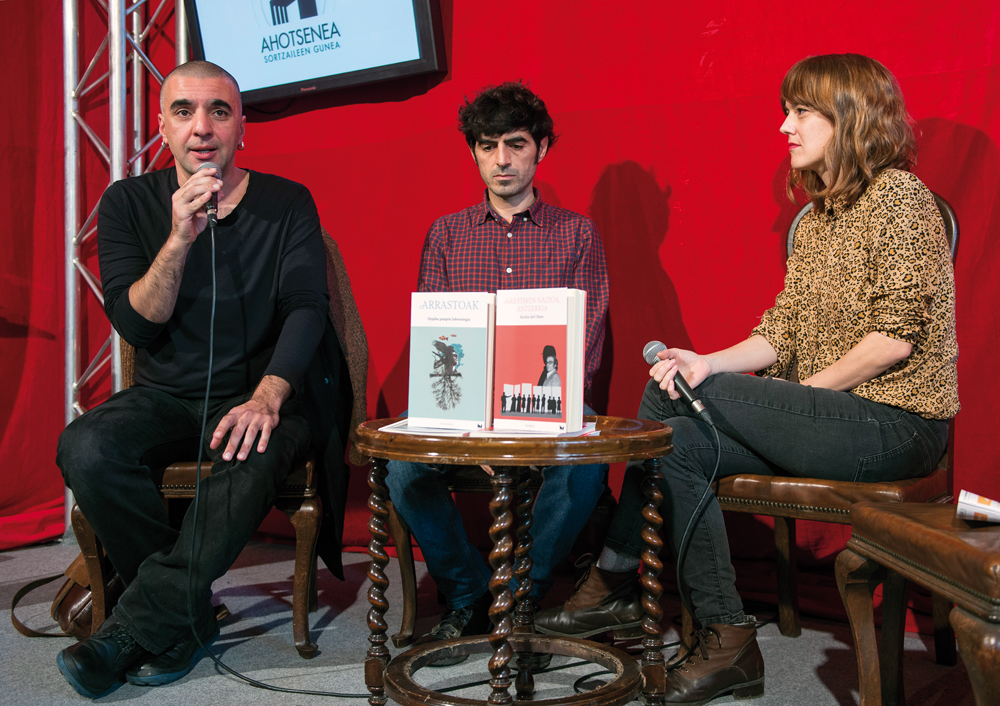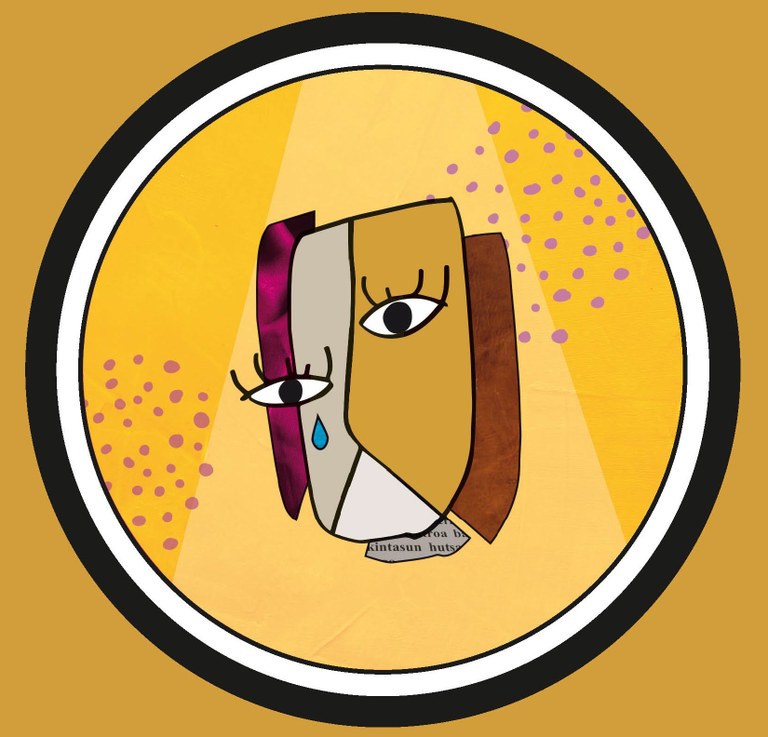Who cares about theater books?
- One of the peculiarities of the literary harvest last year has been the edition of theatre books in Basque. Although the increase has been moderate in number, published papers have given much to talk about. Who reads the following texts that are not written to read? Why bring to the book what is created for the tablement?

“Once it had to have happened, the shortage of theater books has been excessive.” This is a work by Jaime Valverde, member of the Association of Teatro de Euskal Herria EHAZE. The harvest of theatre books in 2016 has been fruitful, not so much in number, but in depth. Four papers have been published: Mr. Mrs. (Oier Guillan, Txalaparta), Erleak, satorrak, Beleak (Gaizka Sarasola, Edo), Habiak. Corners (Dejabu, EHAZE) and the nation of Aresti, theatre (Karlos del olmo, EHAZE). The issue 10 of Erlea magazine has also been devoted entirely to the Basque theatre.
In the words of actress Ainara Gurrutxaga and member of the doll lab Dejabu, these books have been more mentioned than usual for showing a special way of seeing theatre: “The people behind the last theater books have been doing theater for many years. Books are the result of deep work processes, and I would say they've been noticed because they show a new way of seeing the theater. They are the reflection of the theatrical movements created collectively, it is innovation, the energy they bring and the topics being discussed are very current, which generate an echo for today’s reader”. In any case, Gurrutxaga has made it clear that theatre as a literary genre is completely discarded: “You just have to go to libraries.”
Valverde says that, although standard editorials have made a small gap to the theater, readers already exist. “The theater must be published carefully, bearing in mind that the text does not have its own support. On the contrary, strategically and in the long term, it is important that theatre also be disseminated in written form. Among other things, it facilitates access to text channels, libraries or the education system. The place the media gave last year to the theatre has also been, in part, thanks to books.”
Transmission forever
Because the scarcity of theatre books feeds the transmission gap, it is imperative that they be published by EHAZE members. As he said, “the transmission pause is the hangover of our theatre since its inception. Only publications cannot guarantee the transmission of the theater, but it is a way to fill the void.” However, it has called for other needs, such as the lack of a documentation centre: “It takes a structure of its own that works the documentation, that has the theater about to play, with its peculiarities. Because, for example, for those who learn theatre in twenty years’ time, it’s not the same to see the footprints with video than to have access to substantial information about the performance, or to read the text, even if this also says a lot.”
Ainara Gurrutxaga:
“The books published last year are a reflection of the theatrical movements created collectively, that’s innovation.”
Since this annotation of what is remaining without collecting the past and present of the Basque theatre, EHAZE has launched a new collection to publish two publications a year. The line of the editorial project will be twofold: reflections and essays on the one hand, and representations on the other. The first works of this project were presented at the Durango Fair, mentioned above, in the theater play Arrastoak, the nation of Aresti.
Gurrutxaga also says she has felt a “terrible” lack of transmission as an actress. “Suddenly someone tells you that in the 1960s and 1970s there was in Euskal Herria a great alternative movement in the theater, which recognized the most innovative movements worldwide, which staged some of the best writers. There is a lot of ignorance, the same for getting material.” In this regard, it considers that the EHAZE project is key, but in order not to be a “single well in the middle of the desert”, a stronger infrastructure and deeper protection are needed.
How to Live the Play from the Book
There are theater books so that those who could not see the play on stage, otherwise they could enjoy the play. But is it really possible to bring the theater to paper? Gurrutxaga believes that “fortunately” is not possible, because there is always the risk that some elements of “stubbornness” or theatre cannot be picked up. In his words, “a bertsos session is like you can’t take to paper in its entirety, the bertsos yes, but the communication exercise that people have felt in the plaza can hardly be transmitted on paper. However, it’s a very interesting exercise.”
Jaime Valverde EHAZE
“It would take a structure of its own that works the documentation, that has the theater about to play, with its peculiarities”
Understanding theater as a collective action, the writing process to take it to the book Arrastoak has also been collective for Dejabu. Gurrutxaga says it is collective because photos, experiences, memories of all and all have been collected before writing one or two of them. Then, to overcome the “stubbornness” of writing, they have used playwriting notes: “We perform theater based on gestures, movements and images and we have tried to explain where those images were born, with photos and plans, what collages we make, recognizing the books we have read. Creating a theater play is creating a small universe that drinks from film, painting, music, photography. Writing about how this universe is nurtured has been a very nice challenge.”
D. Mrs de Oier Guillan has been one of the most outstanding plays in theatre books, composed of seven theatre plays that have been considered aesthetically innovative. Gurrutxaga has written the preamble to this fact. In this case, the book and the tablate come together in the opposite direction. According to Gurrutxaga, “Oier makes her proposals in writing and then offers them to a group of actors to take her to the stage. The process changes, but I don't think it's that different, because the most important thing is that when you take that text to the stage, it has another material, like the light, the music, the emotions or the improvisations of the actors, that is, it's very flexible. Many times the text is given authority, which I believe does not have to be in theatre.”
According to Valverde, the more the published is interpreted, the more we all like writers, actors, playwrights. It clearly states: “It’s a gown to read, but it’s to bring the theater to the body.”
By:
Mirari Martiarena and Idoia Torrealdai.
When: 6 December.
Where: In the San Agustín cultural center of Durango.
------------------------------------------------------
The fourth wall breaks and interferes directly, standing and fearless. ZtandaP is a way of counting... [+]
By:
Mirari Martiarena and Idoia Torrealdai.
When: 6 December.
Where: In the San Agustín cultural center of Durango.
-------------------------------------------------
The fourth wall breaks and interferes directly, standing and fearless. ZtandaP is a way of counting from... [+]
We're in chaos. That has been said to us by the French media, which Parliament has brought down the government on 4 December. The fear that political, institutional, social, economic chaos will rage us all in the horde of hell comes to our veins. What comedy we're going to play... [+]
Fight and metamorphosis of a woman
By: Eneko Sagardoy and Vito Rogado.
WHEN: 1 December.
WHERE: Serantes Room of Santurtzi.
-----------------------------------------------------------
Immediately after proposing the plan, the person who decided to buy the tickets online... [+]
DEBT
Text and address: Agurtzane Intxaurraga.
Actors: Look at Gaztañaga, Iñake Irastorza, Jabi Barandiaran.
When and where: 25 October, Gazteszena (Donostia).
----------------------------------------
To the flower that is looking for its own light, being grasped at its... [+]
IN
MIÑA Artedrama. Equipment: Sambou Diaby, Ander Lipus, Eihara Irazusta, Mikel Kaye.
WHERE: Arriaga Theatre in Bilbao.
NO: 25 October.
----------------------------------------------
Ibrahima balde and AMETS Arzallus counted in Basque in Miñán in 2019. Five years later... [+]
I started to mentally write my article while I was in the car. I usually have the best ideas in the car while driving alone. I'm going to Bilbao, to the Arriaga theater. The Artedrama company is today staging the Miñan play. It's Friday, October 25.
Approaching the atrium of the... [+]
Text:
Nerea Ibarzabal, Jon Ander Urresti, Matxalen de Pedro and Beñar Urrutia.
Directors and playwrights: Matxalen De Pedro and Jon Ander Urresti.
Actors: Jon Ander Urresti and Beñat Urrutia.
Where: Casa de Cultura Lugaritz (Donostia-San Sebastián).
When: 20... [+]





















